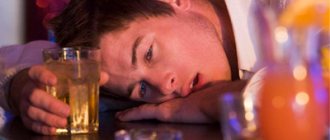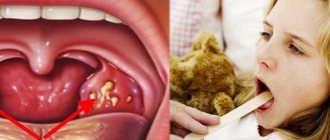Home>Articles>Alcohol withdrawal syndrome
quick menu (hide)
- Alcohol withdrawal symptoms
- Causes
- Treatment of withdrawal syndrome
- How to overcome alcohol withdrawal syndrome
Alcohol withdrawal syndrome is a complex reaction of the body that manifests itself as a result of stopping or reducing the dose of alcohol that has become addictive. An increased risk of the syndrome is associated with the use of psychoactive substances such as drugs, tobacco, ethanol. The manifestation of symptoms of a condition such as alcohol withdrawal syndrome is directly dependent on the composition and amount of alcohol.
Symptoms
The main manifestations include :
- not feeling well,
- Bad mood,
- irritability,
- loss of appetite,
- lethargy,
- depression.
Another name for this condition is alcohol withdrawal or alcohol withdrawal syndrome. ICD 10 encrypts this state - F10.3. The popular names for this condition are hangover or withdrawal symptoms. This condition occurs in all people suffering from addiction. The likelihood of developing this condition is higher when taking substances that are quickly metabolized and easily eliminated from the body. A long period of use and abrupt cessation can cause withdrawal.
The epidemiological picture is heterogeneous. Dependence on antianginal drugs causes withdrawal symptoms in 5-8% of cases. Taking narcotic substances – 100%. Withdrawal is more difficult for the elderly and people suffering from acute or chronic diseases.
What stage of alcoholism is it typical for?
Withdrawal symptoms begin to appear in the second stage of addiction and are necessarily present in the third. It is possible to develop different symptom complexes, which is largely due to the characteristics of a particular person. Up to 15% of patients with severe AAS die.
Clinical options
Withdrawal syndrome usually includes two groups of changes. The first includes the actual pathological attraction to alcohol. But the basis of the clinical picture is made up of various psychophysical disorders, individual for each person.
Psychopathological variant of AAS
When cognitive-behavioral disorders dominate, the development of a psychopathological variant of withdrawal syndrome is confirmed. It has the following signs:
- the appearance of thoughts of suicide;
- behavior aimed at causing harm to oneself (less often, to others);
- anxiety;
- irritability;
- aggression;
- pathological agitation (agitation);
- feeling overwhelmed;
- fear to the point of panic;
- critically reduced mood background – dysphoria;
- guilt;
- sleep disturbances, usually complete insomnia;
- illusions;
- hallucinations – auditory, visual, hypnagogic.
Victims may remain in a half-asleep state, having difficulty understanding the difference between dreams and their surroundings. Disorientation in what is happening and in one’s personality stands out.
This type of AAS is associated with a high risk of developing acute alcoholic psychosis. In severe cases, violations reach the point of delirium - “delirium tremens”.
Neurovegetative variant of AAS
In most cases, neurovegetative type symptoms appear:
- asthenia – loss of the ability for prolonged mental and physical stress, combined with severe weakness, unstable mood, poor tolerance to external stimuli;
- tremor - trembling of different parts of the body, intensifies in a cold room;
- lethargy;
- Some patients have increased body temperature
- redness/pallor of certain areas of the skin;
- fluctuations in blood pressure;
- rapid pulse - tachycardia more than 90-110 beats/min;
- dry mouth;
- heart rhythm disturbances;
- sweating – hyperhidrosis;
- swelling of the face;
- decreased appetite;
- emotional swings;
- exhaustibility;
- hot temper;
- involuntary contraction of facial muscles;
- twitching of fingers and toes;
- muscle weakness;
- unsteadiness when walking or trying to stand;
- thirst;
- feeling of lack of air.
If severe sweating is combined with diarrhea, you should be wary of dehydration with water-electrolyte imbalance. Profuse hyperhidrosis often precedes the appearance of delirium (“squirrel”).
Neurovegetative disorders are a kind of “base” to which other personal symptoms are added. In approximately 5-8% of cases, after prolonged binges, convulsive (epileptiform seizures) are added to withdrawal symptoms.
Detoxification
3 000 ₽
Calling a narcologist to your home
3 000 ₽
Cerebral
Long-term drinking of alcohol leads to damage to the central nervous system. In case of severe damage, the following symptoms are added to the neurovegetative manifestations:
- dizziness;
- sudden shudders;
- numbness of the limbs;
- disorders of consciousness;
- twitching of the eyeballs - nystagmus;
- hyperacusis – weak sounds are perceived as excessively loud and uncomfortable;
- loss of consciousness;
- headaches accompanied by nausea;
- seizures;
- polyneuropathy.
The condition worsens if there is a history of neuroinfections, traumatic brain injuries, or any type of organic brain damage. Some cerebral disorders can persist for a long time even after abstinence has stopped.
Visceral or somatic variant of AAS
In the somatic variant of AAS, signs of dysfunction of internal organs predominate. The following manifestations of visceral disorders are possible:
- diarrhea - loose stools;
- nausea, vomiting;
- excessive gas formation in the gastrointestinal tract (bloating, rumbling);
- coated tongue;
- abdominal pain – paroxysmal, dull, sharp;
- yellowing of the sclera of the eyes;
- dyspnea;
- angina pectoris – pain behind the sternum in the region of the heart, caused by ischemia (impaired blood flow) of the myocardium;
- feeling of “interruptions” in the work of the heart;
- weakness;
- arterial hypertension;
- clinic of neurovegetative variant;
- depressed mood.
There is a tendency towards a protracted, multi-week course of visceral disorders. They are associated with long-term somatic pathology - peptic ulcer (stomach, duodenum), pancreatitis, toxic hepatitis (alcoholic liver disease).
Causes that cause alcohol withdrawal syndrome
It is impossible to say clearly how long this condition lasts.
- Cases of withdrawal withdrawal symptoms are often associated with a person’s independent decision to stop taking it or with a change in the dose of the substance taken.
- Withdrawal occurs after violation of the drinking interval.
- An addict may feel very bad in the morning before taking the first dose. This type of hangover is called the “zero hour phenomenon.”
- Deterioration in health when taking medications, for example, occurs when the active substance is rapidly removed from the body. This condition can occur with diarrhea, vomiting, and kidney failure.
- If you stop taking it abruptly. The formation of withdrawal syndrome is caused by a sudden and complete cessation of ethanol entering the body. The condition is aggravated if the patient has previously taken large doses. Withdrawal can be severe if a person is unable to drink alcohol.
Stages of withdrawal syndrome
At the second stage of alcohol dependence, withdrawal syndrome has three degrees of severity:
- I degree corresponds to vegetative-asthenic disorders. Most often, patients complain of rapid heartbeat, dry mouth, and sweating. There is weak situational control.
- Stage II occurs after an abrupt cessation of many days of intoxication. The clinical picture includes autonomic and somatoneurological disorders. There is a strong desire to get hungover, but drinking alcohol does not improve the condition, but further stimulates abuse.
- III degree of severity is accompanied by the addition of mental, emotional, and behavioral disorders.
At the final stage of alcoholism, AAS can occur in any clinical variant. The more severe the damage to the central nervous system and internal organs, the more varied the clinical picture.
Pathogenesis
Addictive substances change the biochemistry of the body, which normalizes the functioning of :
- endocrine apparatus,
- nervous system,
- internal organs.
Taking medications helps improve the condition of the body and improve well-being. The use of caffeine, alcohol or psychostimulants causes a surge of strength and vigor. Some medications cause sedation and relaxation. In any case, the nervous system responds to the flow of neurotransmitters under the influence of psychoactive substances. Disruption of the natural release of neurotransmitters gradually forms addiction. The functions of organs that are aimed at maintaining normal well-being are reduced. If you suddenly stop drinking alcohol, the body’s systems do not have time to restore the production of neurotransmitters or regulate their intake. This is withdrawal syndrome - a pathology in the functioning of internal organs associated with an imbalance in the transmission of a neural signal, the release of neurotransmitters, hormones and precursors.
Systematization
The most advanced classification of withdrawal symptoms was formed taking into account substances that were addictive. There are withdrawal symptoms when you stop taking the drug :
- ethyl alcohol,
- glucocorticoid drugs,
- nicotine,
- antidepressants,
- opioid substances.
Based on these data, methods have been created to eliminate such a pathological condition as alcohol withdrawal syndrome.
Treatment
The prognosis and treatment tactics are based on the characteristics of the disease.
- Regenerative tactics . It is selected based on the most favorable prognosis. The body can recover on its own without medical intervention.
- Stable forecast . The course of withdrawal is predictable. Proper therapy makes it easy to correct symptoms. The likelihood of repeated exacerbations is minimized.
- Intermittent flow . The period of stabilization of the condition is replaced by a sharp deterioration. Strict adherence to prescriptions ensures a favorable outcome.
- Degenerative . The prognosis is the most unfavorable. Manifestations of withdrawal are poorly controlled. The patient requires hospitalization. Once treatment is completed, the likelihood of relapse is high.
Symptoms
The clinical picture can be determined by the duration of the disease, as well as the amount of alcohol consumed.
Manifestations of alcohol withdrawal syndrome 2-3 days after binge drinking:
- high fatigue
- weakness,
- thirst,
- increased sweating.
After a binge that lasted 3-10 days , the patient experiences:
- redness of the skin,
- blood pressure surges,
- Strong headache,
- nausea and vomiting,
- disturbance of clarity of consciousness,
- tremor of the limbs,
- poor coordination of movements.
At the end of a long binge, the patient experiences nightmares, attacks of unmotivated aggressive behavior, and depression. Alcohol withdrawal syndrome manifests itself in the form of a persistent desire to take another dose, tension, inability to concentrate, chills, and dizziness.
Alcohol withdrawal - symptoms and treatment
Treating withdrawal symptoms does not cure alcohol addiction. It pursues the following goals:
- reduce withdrawal symptoms;
- prevent seizures, delirium tremens and death;
- eliminate problems with electrolytes (substances that help retain fluid in the body) and increase blood sugar levels [2];
- prepare the patient for long-term abstinence from drinking alcohol.
Adequate and prompt treatment of alcohol withdrawal reduces the severity of future withdrawal episodes and the risk that the patient will resume drinking alcohol [18].
Treatment in a hospital is carried out for [15]:
- severe symptoms of alcohol withdrawal, including delirium tremens;
- serious psychiatric problems (suicidal thoughts, psychosis);
- significant laboratory abnormalities, even with a mild form of withdrawal (general blood count indicators - glucose, electrolytes);
- positive urine drug test results.
Treatment at home (outpatient) is advisable for:
- mild or moderate form of withdrawal;
- no contraindications;
- not consuming alcohol for at least five days.
Outpatient treatment is possible provided that you regularly visit a doctor, take prescribed medications, and have someone who will care for the patient and monitor medication intake [6][9].
Family support is critical to the success of outpatient treatment. Therefore, it is important that the person who will look after the patient does so at their own discretion [17].
Outpatient treatment for alcohol withdrawal is generally safe, effective, and less expensive than inpatient treatment [16]. It does not separate the patient from family and work, which is also important in the treatment of alcoholism.
To eliminate alcohol withdrawal syndrome, benzodiazepines, vitamins and anticonvulsants are used.
Benzodiazepines
Benzodiazepines are a typical treatment for alcohol withdrawal. They effectively relieve symptoms and prevent seizures [25][26]. Like anticonvulsants, benzodiazepines reduce psychomotor agitation and prevent the progression of withdrawal symptoms [22]. They should be administered early in withdrawal.
There are two types of benzodiazepines: long-acting and short-acting. Long-acting benzodiazepines such as chlordiazepoxide and diazepam are more commonly used [2]. They are considered superior to other benzodiazepines in the treatment of delirium and allow longer periods between doses [23]. Short-acting benzodiazepines, such as lorazepam, are safer for people with liver problems [7]. However, there is no consensus yet on which type of drug is most suitable for treating withdrawal symptoms.
The main debate between the use of long-acting and short-acting benzodiazepines is ease of use. For example, treatment with lorazepam is equally safe and effective, but it has a shorter duration of treatment and lower dose of medication used [7].
Benzodiazepines should be used with caution : they can cause respiratory problems, depression, suicidal behavior, and death when combined with alcohol. Therefore, this group of drugs can only be used during the period of abstinence from alcohol [29].
With long-term use, there is a risk that alcoholism will change to benzodiazepine or other addiction. Therefore, the drugs should be used only for a short time in alcoholics who are not yet dependent on these drugs.
Benzodiazepines are given when the patient has significant symptoms. Therefore, people with mild alcohol withdrawal may require only supportive care.
The use of benzodiazepines in doses that relieve withdrawal symptoms reduces the clinical manifestations of the syndrome, including the frequency of seizures, while the total dose of drugs taken is less than when treated with fixed doses.
For alcohol withdrawal, benzodiazepines reduce the incidence of delirium and seizures more effectively than phenothiazines and are recommended for use as first-line drugs.
Vitamins
Patients with alcohol withdrawal often experience nutritional deficiencies, which can lead to serious complications. For example, with a deficiency of thiamine (vitamin B1), Wernicke-Korsakoff syndrome may develop. It is accompanied by vitamin deficiency, visual changes (ophthalpolegia, nystagmus), ataxia and memory impairment.
To prevent Wernicke's syndrome, patients should use thiamine, folic acid, and pyridoxine before any carbohydrate-containing fluids or foods. These vitamins are often combined for intravenous administration [30].
Anticonvulsants
Some studies indicate that anticonvulsants, drugs used to treat epilepsy, may help control seizures during alcohol withdrawal [31][32][33]. However, these studies are rare, so the role of anticonvulsants in eliminating seizures during withdrawal has not been proven.
Paraldehyde in combination with chloral hydrate has been shown to be superior to chlordiazepoxide in terms of life-threatening side effects. Paraldehyde, like chloral hydrate, has not only an anticonvulsant, but also a hypnotic effect. It simultaneously helps prevent seizures and eliminate insomnia during alcohol withdrawal.
Carbamazepine is prescribed to increase the threshold of convulsive readiness against the background of alcohol withdrawal, which also reduces the severity of the clinical manifestations of the syndrome (increased excitability, tremor, gait disturbances) [33]. However, it is associated with dizziness, ataxia, double vision, nausea and vomiting [31].
Other drugs
β-blockers and clonidine have been shown to reduce symptoms of alcohol withdrawal syndrome, but there is limited data on their effectiveness against delirium or seizures [22].
Phenothiazines and barbiturates are not recommended for outpatient treatment of alcohol withdrawal [22]. Phenytoin (Dilantin) is not effective in treating or preventing seizures, and magnesium sulfate is not effective in treating withdrawal symptoms.
Preventing further alcohol use
There are three medications that help prevent relapse into alcohol use: naltrexone, acamprosate, and disulfiram. They are used after relief of withdrawal [24].
Antipsychotics (haloperidol) are sometimes used in addition to benzodiazepines to control agitation or psychosis [8]. Antipsychotics may potentially worsen alcohol withdrawal because they lower the seizure threshold. In particular, due to their anticholinergic properties, tricyclic antidepressants, especially amitriptyline, as well as the antipsychotic azaleptin (leponex, clozapine), when prescribed during a period when withdrawal symptoms still persist, can cause psychotic disorders such as delirium. Moreover, it is inappropriate to use amitriptyline and azaleptine during the abstinence period as sleeping pills, which, unfortunately, is practiced [28].
Successful treatment of alcohol withdrawal is the first step to long-term abstinence. If, after recovering from alcohol withdrawal, the patient does not enroll in individual or group therapy and do not begin long-term drug treatment to reduce the risk of relapse, then he is unlikely to abstain from drinking alcohol [9].
Monitoring patients during home treatment
The frequency of visits to the doctor depends on the severity of symptoms, the characteristics of the patient and his environment. Most patients see their doctor daily until their symptoms subside.
At each visit, the doctor should measure your blood pressure and pulse. Periodically, he performs a breath test and reassesses the severity using the CIWA-Ar criteria. When the CIWA-Ar score is less than 10, medication dosages are reduced and eventually the medications are stopped completely.
Symptoms should be resolved within seven days of abstaining from alcohol. If after stopping the medication the patient has not drunk alcohol for at least three days, then he can be referred to a long-term outpatient alcohol treatment program.
Patients who do not respond to benzodiazepine therapy, skip medications, or start drinking again should be referred to a drug addiction specialist or admitted to hospital for treatment.
Why is it better to see a doctor?
Patients often try to get rid of withdrawal symptoms by drinking alcohol. This tactic reduces the likelihood of alcoholic delirium, but does not help to cope with disturbances in the functioning of internal organs and aggravates the problem of alcohol dependence.
Self-treatment errors:
- Patients do not control and do not correct their physical condition, and therefore the risk of heart attack, stroke, gastrointestinal bleeding increases sharply, and the course of chronic diseases such as diabetes mellitus and heart failure worsens.
- Alcohol addicts self-administer sedatives. Uncontrolled use of Corvalol and other sedatives leads to the development of drug resistance and worsening withdrawal symptoms. When taking barbiturates (Corvalol) and parallel alcoholism, epileptic foci may occur.
- Due to late seeking medical help, alcoholic psychosis (delirium, delirium tremens) may develop - the most common serious consequence of alcohol consumption. Even after recovering from delirium, patients continue to have problems with attention and memory for a long time, and may develop alcoholic dementia and neuropathy.
As a rule, relatively healthy patients are taken out of short binges at home. Even early signs of delirium and concomitant pathology (previous heart attacks, strokes, traumatic brain injuries, decompensated diabetes mellitus, heart failure, etc.) require treatment in a hospital.
Violation of these requirements is fraught with the development of critical situations (cardiogenic shock, impaired breathing and consciousness) in conditions where it is not possible to provide the patient with full assistance.
Traditional methods of treating alcohol withdrawal
The most effective folk method of combating withdrawal symptoms is drinking plenty of fluids, as it has a detoxifying effect. However, without medication support it will not be possible to cope with problems with the functioning of internal organs, since excessive fluid intake leads to disturbances in the metabolism of electrolytes (K, Na, Ca) and vitamins. Drinking heavily also does not solve the issues of symptomatic therapy - the patient continues to have sleep disorders, anxiety, and an increased risk of psychosis.
Nutrition
Alcohol has a high energy value, so its abuse dulls a person’s feeling of hunger. The patient begins to eat poorly, eats foods according to the “residual principle”, since the main priority is drinking alcohol. As a rule, in case of persistent and long-term binge drinking, food intake stops altogether. During and after the cessation of alcohol withdrawal, a sufficient amount of vitamins and microelements should be included in the diet. It is necessary to follow a drinking regime, control the salt content in food and consume acidic foods with caution.
Complications
Many addicts and their relatives believe that a hangover can be survived without the help of a doctor and taking appropriate medications. Withdrawal syndrome without timely and complete treatment leads to serious depletion of the body and dystrophic changes in many organs and tissues. When taking large doses of alcohol, the body cannot quickly recover on its own. Withdrawal can last a long time, accompanied by convulsive attacks, with episodes of involuntary bowel movements, and difficulty breathing. In particularly severe cases, there is a risk of sudden cardiac arrest.
Consequences of withdrawal
With withdrawal syndrome, a person is in an unstable mental state: he experiences outbursts of anger, manifestations of aggression and irritability. The development of somatic and vegetative complications leads to the fact that the patient is unable to perform even basic actions until he drinks a new portion of alcohol to recover from his hangover. Thus, a person can no longer live fully without a bottle. In this case, complications appear both the next morning after drinking and after several days.
mental disorders may occur 3-5 days after stopping use
- hallucinations,
- paranoia, delusion, persecution mania,
- deterioration of thinking abilities,
- manifestations of epilepsy,
- memory loss,
- delirium delirium
However, the matter does not end there. If a person stubbornly continues to drink and prolong the binge, then other diseases will soon worsen, such as:
- ulcer,
- diabetes,
- renal and/or liver failure.
Alcoholism can lead to cirrhosis, heart disease and alcoholic hepatitis.
Mental abilities also suffer during withdrawal symptoms. With prolonged use of alcohol the following are observed:
- general inhibition of the thought process,
- constantly emerging delusional associations,
- unproductive thinking (an alcoholic is unable to make important decisions and conduct meaningful dialogue),
- depressive state, general depression, gloominess, inability to perceive humor,
- destruction of the system of spiritual values,
- alcohol and the subsequent state of intoxication become the main meaning of a person’s life,
- low self-esteem,
- presence of suicidal thoughts
The severity of symptoms directly depends on how long alcohol dependence continues. The longer, the stronger the mental and mental problems manifest themselves.
Diagnosis
When you stop taking ethanol, making a diagnosis is carried out not only by a therapist or a narcologist, but also by:
- endocrinologist,
- cardiologist,
- neurologist
- or a psychiatrist.
The general direction is to assess health status and record symptoms that require immediate treatment. Comprehensive measures include :
- Survey . Confirmation or diagnosis is made after establishing the fact of prolonged drinking and subsequent abrupt cessation. During the interview, the doctor records the patient’s complaints and the time of occurrence of withdrawal symptoms, the frequency and duration of symptoms,
- Inspection . The neurologist checks the body's reflex responses, its sensitivity, and coordination of movements. Other specialists record the condition of the skin, mucous membranes, the color of the whites of the eyes, auscultate the chest, measure the pulse,
- Laboratory research . Most often, the patient undergoes laboratory clinical and biochemical tests of blood and urine. Other tests are prescribed based on the patient’s complaints or as necessary to clarify diagnoses. Studies of the concentration of hormones and other markers that indicate the functioning of the heart, kidneys or liver may be prescribed.
Why clients trust us:
Free consultation
We have been working for more than 8 years
We work all over Russia
We guarantee anonymity
We help in difficult cases
Help for relatives
Consequences of alcohol withdrawal syndrome
All signs of alcohol withdrawal can lead to serious consequences - cardiac dysfunction, heart attack, stroke, damage to certain areas of the brain, etc. That is why it is extremely important not to leave things to chance, but to contact a specialist. Medical intervention will minimize the consequences or eliminate them in time
Diagnosis of post-alcohol symptoms
The diagnosis is made based on the following questions:
- is there vomiting, nausea;
- degree of hand tremors and sweating;
- the level of emotional stress of the patient;
- is a person oriented in space, does he understand who he is, what day of the week, etc.;
- presence of anxiety, panic attacks, sleep disturbances.
The presence of at least two items from the list indicates withdrawal syndrome. To assess the degree of dependence on alcohol, narcologists also use a special survey.
Treatment
The selection of therapeutic treatment methods is determined by the symptoms, the severity of the condition, the ability and desire of relatives who are concerned about how to alleviate alcohol withdrawal syndrome, provide care, and the presence of complications of chronic diseases.
Treatment can be carried out at home or in a hospital setting. In especially severe cases, treatment can be carried out under anesthesia with the patient placed in the intensive care unit or intensive care unit. The standard scheme is based on the following activities.
Detoxification promotes the rapid elimination of ethanol breakdown products from the body. Infusion therapy is prescribed. Including saline, glucose, diuretic, antidotes, neutralizing the effects of toxins, heabsorption, plasmapheresis or hemodialysis. The mild severity of the syndrome allows the use of biologically gentle methods - drinking plenty of fluids, taking absorbents and decoctions of medicinal herbs.
Description
Withdrawal syndrome is characterized by the appearance of various body reactions that occur as a result of quitting alcohol consumption. Occurs after prolonged consumption of alcoholic beverages over several days or weeks, as well as in chronic alcoholics who drink alcohol for a long time and in large doses.
Signs of the condition begin 6-48 hours after the last dose taken, and continue for several days or even several weeks. It is accompanied by disruption of various body functions, which can cause dangerous and pleasant symptoms. The severity of the condition depends on the duration of alcohol consumption. It is most difficult for older people and patients with chronic diseases.
How to overcome alcohol withdrawal syndrome
In some cases, to alleviate the patient's condition, it is recommended to correct the stages of withdrawal. It involves returning to taking a psychoactive substance followed by a gradual reduction in dose. The procedure should be carried out in several stages with mandatory medical supervision.
First, a dose must be selected that will immediately stabilize the patient's condition. After a day, a gradual reduction in the dose begins and the situation is brought to complete failure. If the patient's condition worsens sharply, the pace of treatment is slowed down. After complete withdrawal, the patient should be under medical supervision for two days.
Eliminating dangerous symptoms
To correct the condition of the addict during the withdrawal period, symptomatic therapy is used. Symptoms such as convulsions and hallucinations must be eliminated. The patient receives painkillers, antipyretics, and antihypertensive medications. The choice of drugs, dosage and duration of administration are prescribed by the attending physician based on the patient’s condition. Treatment at home should be preceded by agreement on the use of certain medications with the treating specialist based on symptoms.
General strengthening measures
The earliest possible normalization of the patient's condition after acute withdrawal should be accompanied by bed rest. Physical activity should be restored gradually. The patient is prescribed walks, light physical exercise, and feasible household work. Overwork during this period is undesirable. The menu should be dominated by liquid dishes - soup, broth, jelly, compote. The patient is prescribed vitamin and mineral complexes.
How to cope with PAS symptoms?
- It must be recognized that subacute withdrawal syndrome is the result of prolonged intoxication of the body with alcohol or drugs. The physical consequences that appear are treated, and attention should not be focused on the “pulsating” feelings of guilt and shame. Asking for help is not only normal, but necessary.
- Observation of physical and emotional state. We must learn to recognize the stages when the reaction to stressful situations gets out of control.
- It is important to understand that the symptoms that appear are part of the addiction. They say that the brain is functioning inadequately due to intoxication and most likely will not return to normal for years.
- Hiding your symptoms means making the situation worse. You need to talk about them openly to get feedback. Surely someone has already experienced this and learned to cope with it. Communication is calming.
- It is better to fill your time with activities that are related to recovery. And also always be close to the meeting place and the mentor. Then help will come faster if it is needed.
- Quality nutrition is important. During periods of use, most addicts are malnourished. This habit continues during recovery. A balanced and regular meal reduces the symptoms of PAS and also promotes rapid recovery of the brain and nervous system.
- Do not abuse caffeine and nicotine, which can aggravate the condition. In addition, they are addictive.
- Good sleep, regular relaxation and meditation are the keys to a calm attitude even in painful situations.
- Physical activity - exercise for 30 minutes 3-4 times a week.
- You should regularly monitor your symptoms by discussing them with a mentor. It will help you see progress, problem areas, and the prospects for recovery.
- It's worth learning techniques to help reduce stress. During times of stress, symptoms always become more pronounced, so learning to manage your emotions is the key to success for a recovering person.







